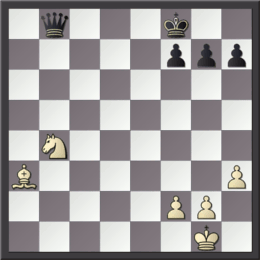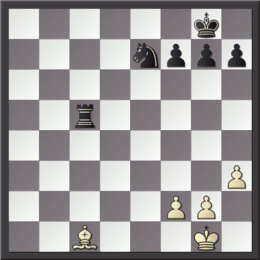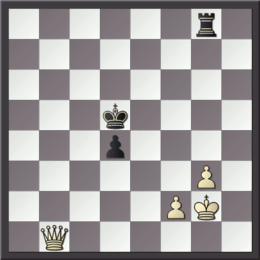Chess tactic
This article includes a list of general references, but it lacks sufficient corresponding inline citations. (February 2010) |
In chess, a tactic refers to a sequence of moves which limits the opponent's options and may result in tangible gain. Tactics are usually contrasted with strategy, in which advantages take longer to be realized, and the opponent is less constrained in responding.
The fundamental building blocks of tactics are move sequences in which the opponent is unable to respond to all threats, so the first player realizes an advantage. This includes forks, skewers, batteries, discovered attacks, undermining, overloading, deflection, pins and interference.[1]
- The Encyclopedia of Chess Middlegames gives the following tactical categories: Double Attack, Pawns Breakthrough, Blockade, Decoying, Discovered Attack, Passed Pawn, X-ray Attack, Interception, Deflection, Pin, Demolition of Pawns, Overloading, Annihilation of Defense, Pursuit (perpetual attack), Intermediate Move, and Space Clearance.
Often tactics of several types are conjoined in a combination.
Attacking and defending pieces
A piece is said to attack (or threaten) an opponent's piece if, in the next move, it could capture that piece. A piece is said to defend (or protect) a piece of the defender's color if, in case the defended piece were taken by the opponent, the defender could recapture right away. Attacking a piece usually, but not always (see sacrifice), forces the opponent to respond if the attacked piece is undefended, or if the attacking piece is of lower value than the attacked one.
When attacked, one has several options:
- Capture the attacking piece.
- Move the attacked piece.
- Interpose another piece in between the two.
- Guard the attacked piece and permit an exchange.
- Pin the attacking piece so the capture becomes illegal or unprofitable.
- Use a zwischenzug.
- Create a counter-threat.
Gaining material
When one player is able to capture an opponent's piece or pieces without losing any of his own, that player is said to have gained material, that is, he will have more pieces on the board. The goal and threat of each basic tactic is to win material. At the professional level, it's often merely the threat of material loss that causes one player or the other to fall into a strategically worse position. In amateur games however, tactics are often overlooked by one player, and so the execution of tactics for material gain is the most common way to achieve a decisive advantage. Material gain can be accomplished by several different types of tactics.
Discovered attack
| a | b | c | d | e | f | g | h | ||
| 8 |  | 8 | |||||||
| 7 | 7 | ||||||||
| 6 | 6 | ||||||||
| 5 | 5 | ||||||||
| 4 | 4 | ||||||||
| 3 | 3 | ||||||||
| 2 | 2 | ||||||||
| 1 | 1 | ||||||||
| a | b | c | d | e | f | g | h | ||
A discovered attack is a move which allows an attack by another piece. A piece is moved away so as to allow the attack of a friendly bishop, rook or queen on an enemy piece. If the attacked piece is the king, the situation is referred to as a discovered check. Discovered attacks are powerful as the moving piece may be able to pose a second threat.
A special case of a discovered check is a double check, where the piece being unmasked and the piece being moved attack the enemy king. A double check requires that the opponent moves his/her king as the king is under attack from two directions and it is impossible to counter both at the same time in any other way.
 |

|
|---|---|
| Animated example of a Discovered Attack | Animated example of a Discovered Check |
Fork
A fork is a move that uses one piece to attack two or more of the opponent's pieces simultaneously, hoping to achieve material advantage, since the opponent can only counter one of the two threats. Knights are often used for forks, with their unique moving and jumping ability. A common situation is a knight jumping to c2 or c7, thereby threatening both the enemy rook and the king. Such "king forks" are particularly effective, because the opponent is forced by the rules of the game to alleviate the threat to the king. The opponent cannot choose to defend the other piece, and thus cannot use a zwischenzug to complicate the situation. Pawns can also be effective for forking. By moving a pawn forward, it may attack two pieces; one diagonally to the left and one diagonally to the right.
Queens are also excellent forking pieces, because they can move in eight different directions. However, this is only useful if both pieces are undefended, or if one is undefended and the other is the opposing king. The queen is the most valuable piece (excluding the king), so it is usually not profitable for it to capture a defended piece.
Fork attacks can be either 'Relative', which is when the attacked units are any of the Pawns, Knights, Bishops, Rooks, or Queen(s). Or, the Fork attacks can be 'Absolute', which is when one of the attacked pieces includes the King.
 |

|
|---|---|
| Animated example of a Relative Fork Attack | Animated example of an Absolute Fork Attack |
Pin
| a | b | c | d | e | f | g | h | ||
| 8 |  | 8 | |||||||
| 7 | 7 | ||||||||
| 6 | 6 | ||||||||
| 5 | 5 | ||||||||
| 4 | 4 | ||||||||
| 3 | 3 | ||||||||
| 2 | 2 | ||||||||
| 1 | 1 | ||||||||
| a | b | c | d | e | f | g | h | ||
A pin is a move which forces one of the opponent's pieces to stay put because moving it would expose a more valuable piece behind it. Sometimes pinned pieces cannot move at all, as doing so would expose the king. Only bishops, rooks, and queens can pin other pieces, because they can move more than one square in a straight line.
Pin attacks can be either 'Relative' or 'Absolute', as shown by the two animated images, below. The Absolute Pin is where the more valuable piece behind is the King (this is the distinguishing feature between Absolute and Relative Pins).
 |

|
|---|---|
| Animated example of a Relative Pin Attack | Animated example of an Absolute Pin Attack |
Skewer
A skewer is a move which attacks two pieces in a line, similar to a pin, except that the enemy piece of greater value is in front of the piece of lesser value. After the more valuable piece moves away, the lesser piece can be captured. Queens, rooks, and bishops can perform the skewer.
Skewer attacks can be either 'Relative' or 'Absolute', as shown by the two animated images, below. The Absolute Skewer is where the more valuable piece in front is the King (this is the distinguishing feature between Absolute and Relative Pins).
With Absolute Skewers, because it's the King that's attacked, the King is in Check and, unless the attacker can be dealt with (by capture, or by blocking the Check with a Pawn or another Piece), the attacked King will have to step aside, allowing the attacking unit to capture the less valuable Pawn or Piece behind.
If the attacked unit wasn't the King - say, a Rook - then it would be a Relative Skewer and should the situation require it, the Rook 'could' remain in place, at risk of being captured, for the sake of protecting whatever unit is behind.
 |

|
|---|---|
| Animated example of a Relative Skewer Attack | Animated example of an Absolute Skewer Attack |
Pawns
Pawns are extremely useful in the game and are far more powerful than meets the eye. For instance, since pawns are the least valuable chess piece, they can be used to capture defended pieces. A single pawn approaching will force a more powerful piece, such as a rook or a knight, to retreat. A simple move of a pawn may reveal a hidden threat (see Discovered attacks). Also, when pawns are arranged in a diagonal line, with the frontmost pawns guarded by the pawns behind, they form an almost impenetrable wall capable of protecting any pieces directly behind them. Furthermore, a pawn which has progressed all the way to the opposite side of the board may be promoted to any other piece except a king. However, a weak pawn structure can be a big weakness.
Sacrifices
| a | b | c | d | e | f | g | h | ||
| 8 |  | 8 | |||||||
| 7 | 7 | ||||||||
| 6 | 6 | ||||||||
| 5 | 5 | ||||||||
| 4 | 4 | ||||||||
| 3 | 3 | ||||||||
| 2 | 2 | ||||||||
| 1 | 1 | ||||||||
| a | b | c | d | e | f | g | h | ||
Sacrificing some material is often necessary to throw the opponent's position out of balance. The sacrificed material is sometimes able to be regained with interest a couple of moves later. Pawn sacrifices in the opening are known as gambits; they are usually not intended for a short-term gain, but instead to achieve a more active position.
Direct attacks against the enemy king are often started by sacrifices. A common example is sacrificing a bishop on h2 or h7, checking the king, who usually must take the bishop. This allows the queen and knight to develop a fulminate attack.
Zugzwang
Zugzwang (German for compulsion to move) occurs when a player is forced to make an undesirable move. The player is put at a disadvantage because he would prefer to pass and make no move, but a move has to be made, all of which weaken his position. Situations involving zugzwang occur uncommonly, but when they do occur, it is almost always in the endgame, where there are fewer choices of available moves.
Zwischenzug
Zwischenzug (German for intermediate move) is a common tactic which, instead of countering a direct threat, a move is played which poses an even more devastating threat, often an attack against the queen or the king. The opponent has to counter that threat first, and this will ideally change the situation to a disadvantage for that player.
The concept of a zwischenzug is often listed as a tactic, but might properly be called a counter-tactic instead. The effect of a zwischenzug is to change the status quo before a tactic can come to fruition. The near ubiquity of the zwischenzug makes long combinations all the more rare and impressive.
See also
References
- ^ Edward R. Brace, Illustrated Dictionary of Chess (Fodor's Travel Publications, 1978) ISBN 978-0-679-50814-4
Further reading
- Yasser Seirawan (2005), Winning Chess Tactics, Everyman Chess, ISBN 1-85744-385-3
External links
- Chess Tactics Organization - Learn chess tactics
- Tactics technical paper suite
- ChessGYM - Tactical chess problems
- Chess Tactics Server - Tactical chess problems
- Chess Tempo - Tactical chess problems
- Chess Tactics Repository - Tactical chess problems
- Adaptive Tactics Server -- Tactical chess problems
- ChessQuads Tactics Server -- User Ranked Tactical chess problems
- IdeaChess -- Tactical chess problems
- Chess Tactics Videos -- Includes video clips of 15 different Chess Tactics
